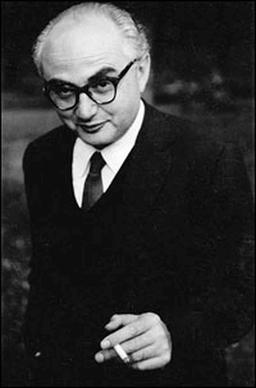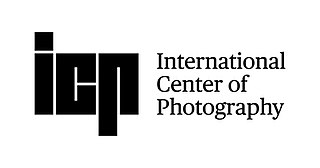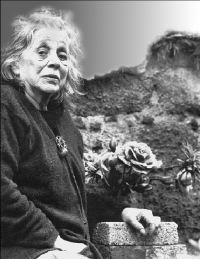
A civil defense siren is a siren used to provide an emergency population warning to the general population of approaching danger. Initially designed to warn city dwellers of air raids during World War II, they were later used to warn of nuclear attack and natural disasters, such as tornadoes. The generalized nature of sirens led to many of them being replaced with more specific warnings, such as the broadcast-based Emergency Alert System and the Cell Broadcast-based Wireless Emergency Alerts and EU-Alert mobile technologies.

Robert Capa was a Hungarian-American war photographer and photojournalist. He is considered by some to be the greatest combat and adventure photographer in history.

Marc Riboud was a French photographer, best known for his extensive reports on the Far East: The Three Banners of China, Face of North Vietnam, Visions of China, and In China.
Ingeborg Hermine "Inge" Morath was an Austrian photographer. In 1953, she joined the Magnum Photos Agency, founded by top photographers in Paris, and became a full photographer with the agency in 1955. Morath was the third wife of Pulitzer Prize-winning playwright Arthur Miller; their daughter is screenwriter/director Rebecca Miller.

Magnum Photos is an international photographic cooperative owned by its photographer-members, with offices in Paris, New York City, London and Tokyo. It was founded in 1947 in Paris by photographers Robert Capa, David "Chim" Seymour, Maria Eisner, Henri Cartier-Bresson, George Rodger, William Vandivert, and Rita Vandivert. Its photographers retain all copyrights to their own work.

Henri Cartier-Bresson was a French artist and humanist photographer considered a master of candid photography, and an early user of 35mm film. He pioneered the genre of street photography, and viewed photography as capturing a decisive moment.

David Seymour, or Chim, was a Polish photographer and photojournalist.

Eve Arnold, OBE (honorary), FRPS (honorary) was an American photojournalist, long-resident in the UK. She joined Magnum Photos agency in 1951, and became a full member in 1957. She was the first woman to join the agency. She frequently photographed Marilyn Monroe, including candid-style photos on the set of The Misfits (1961).

Elliott Erwitt was a French-born American advertising and documentary photographer known for his black and white candid photos of ironic and absurd situations within everyday settings. He was a member of Magnum Photos from 1953.

The International Center of Photography (ICP) is a photography museum and school at 84 Ludlow Street on the Lower East Side of Manhattan in New York City. ICP's photographic collection, reading room, and archives are at Mana Contemporary in Jersey City, New Jersey. The organization was founded by Cornell Capa in 1974. It is located at 84 Ludlow Street, within the Lower East Side.

The Spanish Civil War (1936–1939) broke out with a military uprising in Morocco on July 17, triggered by events in Madrid. Within days, Spain was divided in two: a "Republican" or "Loyalist" Spain consisting of the Second Spanish Republic, and a "Nationalist" Spain under the insurgent generals, and, eventually, under the leadership of General Francisco Franco.

War photography involves photographing armed conflict and its effects on people and places. Photographers who participate in this genre may find themselves placed in harm's way, and are sometimes killed trying to get their pictures out of the war arena.

Gerta Pohorylle, known professionally as Gerda Taro, was a German war photographer active during the Spanish Civil War. She is regarded as the first female photojournalist to have died while covering the frontline in a war.

Cornell Capa was a Hungarian-American photographer, member of Magnum Photos, photo curator, and the younger brother of photo-journalist and war photographer Robert Capa. Graduating from Imre Madách Gymnasium in Budapest, he initially intended to study medicine, but instead joined his brother in Paris to pursue photography. Cornell was an ambitious photo enthusiast who founded the International Center of Photography in New York in 1974 with help from Micha Bar-Am after a stint of working for both Life magazine and Magnum Photos.

During World War II, the German city of Heilbronn was bombed numerous times by the British Royal Air Force and the United States Army Air Forces. The largest air-raid occurred on December 4, 1944, but Heilbronn was targeted several times before and after until the end of World War II. Altogether, an estimated 7,000 inhabitants of the city lost their lives during bombings.

The Falling Soldier is a black and white photograph by Robert Capa, claimed to have been taken on Saturday, September 5, 1936. It was said to depict the death of a Republican soldier from the Libertarian Youth (FIJL) during the Battle of Cerro Muriano of the Spanish Civil War. The soldier in the photograph was later claimed to be the anarchist militiaman Federico Borrell García.

The Magnificent Eleven are a group of photos of D-Day taken by war photographer Robert Capa. Capa was with one of the earliest waves of troops landing on the American invasion beach, Omaha Beach. Capa stated that while under fire, he took 106 pictures, all but eleven of which were destroyed in a processing accident in the Life magazine photo lab in London, although the accidental loss of the remaining negatives has been disputed. The surviving photos have since been called the Magnificent Eleven. The pictures have been widely celebrated, and Steven Spielberg is said to have been inspired by them when filming Saving Private Ryan.

Dezső Révai was a Hungarian photographer and photo journalist who is mainly known for his photographs taken during the Spanish Civil War.

Kati Horna, born Katalin Deutsch, was a Hungarian-born Mexican photojournalist, surrealist photographer and teacher. She was born in Budapest, at the time part of the Austrian-Hungarian Empire, lived in France, Germany, Spain, and later was naturalized Mexican. Most of her work was considered lost during the Spanish Civil War. She was one of the influential women photographers of her time. Through her photographs she was able to change the way that people viewed war. One way that Horna was able to do this was through the utilization of a strategy called "gendered witnessing". Gendered witnessing consisted of putting a feminist view on the notion that war was a predominantly masculine thing.

Gestapo Informer Recognized by a Woman She Had Denounced, full title Gestapo Informer Recognized by a Woman She Had Denounced, Deportation Camp, Dessau, Germany, is a black and white photograph taken by Henri Cartier-Bresson in 1945. It is one of the most famous post-World War II pictures.



















